Don Tatnell Leisure Centre
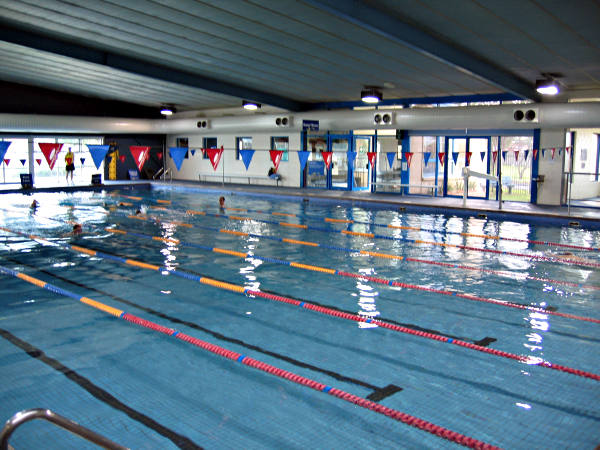
Swimming Pool at Don Tatnell Centre, 2009. Courtesy Kingston Collection.
Port Phillip Bay experienced one of the worst storms in its history in November 1934. The Mordialloc foreshore was struck with huge waves and violent squalls. [1] The Mordialloc Baths took such a battering that it was estimated that £3000 would be required to repair the damage. [2] Councillors were loath to find this money particularly as the community had been struggling to cope with the impact and consequences of the Great Depression. Finally it was resolved to demolish what remained of the baths but a small core of people pressed for the creation of an alternative swimming venue where children and adults could safely swim. [3] A concrete pool was suggested but more than forty years were to pass before a swimming venue was built some distance from the foreshore in Warren Road, Mordialloc. This was the Don Tatnell complex, officially opened in December 1979.
During the period after the World War II, especially the two decades prior to 1979, the Mordialloc Council was lobbied by parents, teenagers and local organisations to build a community centre. While several councillors saw the need and agreed in principle that something should be done they believed the timing was not right. For them and fellow councillors the construction of roads, building of drains and provision of garbage collection services had higher priority. Nevertheless while the absence of money was a problem the pressure for the building of a youth centre persisted. [4] While Mrs Shean, for example, was strongly opposed to a levy to build the youth centre she ardently supported the notion of a swimming pool. In her letter to the local newspaper she pointed out that while there were nine schools and several scout troops in the municipality there was no place for proper swimming instruction. [5]
A Mentone meeting, called to discuss a tentative plan for a Youth Centre in Warren Road, Mordialloc, focussed for much of the time on the proposed swimming pool. This was seen to be the most expensive part of the overall proposal. A three member committee was formed to investigate the costs associated with running a swimming pool, its expected revenue, the comparative popularity of closed and open swimming pools, and the likely effect of the pool’s close proximity to the beach. [6]
The committee reported that a 25 metre pool was a financial reality and that local heads of schools were very supportive of the proposal. A professional swimming coach and member of the committee pointed out that those swimmers who wanted to train were obliged to travel to inner suburban pools or confine their training to the beach during the summer season. Yet even then they were subjected to the vagaries of the weather, and jelly fish. On the open beach it was impossible for competitive swimmers to practise starts and turns. Also in contrast with the open beach, parents supported a facility where their children could safely swim under supervision. [7]
It was on 12 October 1961 that the City of Mordialloc News published a sketch of the proposed youth centre complex consisting of a main hall, a canteen, kitchen, covered swimming pool and meetings rooms for quiet activities to be built in Warren Road. The estimated cost was £90,000. This amount of money was not available so strategies had to be adopted to overcome the deficiency. The planning committee put to the Council in 1962 that the centre’s construction should be undertaken in three stages. The first stage was to consist of a gymnasium and club building. The second stage provided for an open air swimming pool while the third and final stage involved covering the pool and installing a heating plant for the pool and gymnasium.
Discussion and argument proceeded for some time with councillors expressing concern about the cost and viability of the project. By the end of 1963 the proposal to build a youth centre had been modified although the notion of a three stage development persisted. The first stage was again concerned with the building of a gymnasium and hall. Stage two had become the provision of reading rooms, library, television room, art and craft rooms together with rooms for quiet activities. The construction of an unroofed swimming pool costing £26,612 was to be stage three. [8]
Part of the vision was achieved on 30 April 1965 when the Governor of Victoria, Sir Rohan Delacombe officially opened the centre on its site in Warren Road but its committee did not lose sight of the fact that much still had to be achieved. After struggling to raise the money, 2 July 1972 saw the official opening of stage two of the plan when the Mayor of Mordialloc, Cr Kevin Hayes, and the president of the club, the Hon W R Ward, performed the opening ceremony. The completion of Stage three was to take a little longer. Nevertheless, a swimming pool sub-committee was formed to explore the feasibility of building a pool and members set about visiting established pools with a questionnaire which included questions about management, maintenance costs, staffing, school usage, charges and hours of operation. [9] [10]
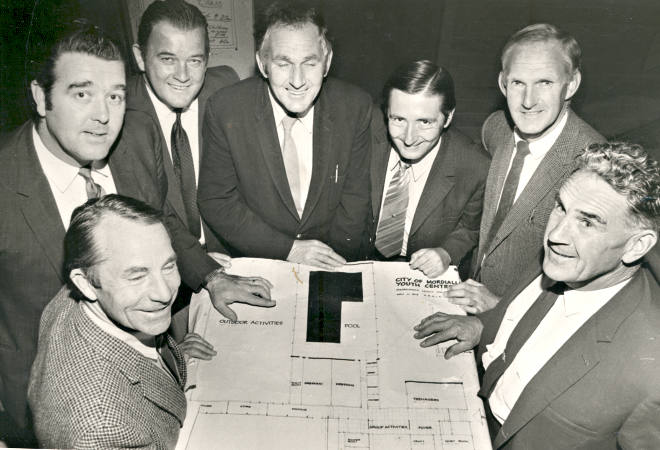
Swimming Pool Committee – Mordialloc Youth Centre. Trevor Ryan, Brian Horwarth, Bevis Glynne, John Earp, Jack Touzel, Bill Nixon, George Simmons around the plan of the pool, 1979. Courtesy Kingston Collection.
While Council had supported the first two stages of the youth centre it did not support the third. This rejection followed a Council study to assess the feasibility of the project. The reaction of the Youth Centre committee of management was to conduct their own studying in March 1973 and use its results to promote their cause. Five months later a public meeting attended by approximately two hundred people and some prominent public figures was held, drawing attention to what they believed was Council’s responsibility to support the pool proposal. Brian Dixon, the Minister for Youth Sport and Recreation, pointed out that physical fitness was necessary for alertness and mental fitness and urged all present at the meeting not to delay their plans for a swimming pool. Sporting identity, Harry Beitzel, earnestly encouraged them to commit themselves to achieving their goals. ‘Think positively’, he said. Bill Nixon recalled ‘Harry Beitzel was the first person to donate to the fund to build the pool. After giving a great talk praising the project he reached into his pocket and pulled out a bundle of notes and donated $100 to the cause even though he was not a local resident.’ [11] Roy Ward a member of the State parliament and president of the youth centre, supported their call.
It was almost two and a half years after the public meeting that Council revised some of its priorities. ‘Cleaning up the Mordialloc Creek’ was dropped from its position as the number one priority to allow its place to be taken by the swimming pool project. The town clerk, Doug Corben, explained that the State Government had taken responsibility for the cleaning of the creek and the Dandenong Valley Authority would spend $750,000 in removing the rubbish in the creek at no cost to the ratepayers. The Department of Youth Sport and Recreation was notified that the Council’s first priority for subsidies from that department was for the construction of a swimming pool complex. Cr Max Garfield successfully moved in Council that the priorities be changed despite the opposition of Cr Mal Buxton who thought the change was premature until they had a firm commitment from the Premier that the work on the Mordialloc creek would be done. [12]
In April 1977 Council formed a sub-committee of four councillors to liaise with the Youth Centre to determine the extent of the project and its financial viability. As a result, at the end of that year, Council was presented with the results of a feasibility study which recommended the establishment of a 25 metre indoor heated pool, four squash courts, two saunas and ancillary facilities. Council then applied to the Department of Youth Sport and Recreation for financial assistance. A subsidy of $121,250 was granted together with an interest-free loan of $109,250. The Youth Centre committee offered $30,000 together with a further $70,000 to be raised through a public appeal. In the same month F Saunders of Jennings Industries Ltd wrote to F Tighe, secretary of the Mordialloc Community Youth Centre, indicating his company’s interest in offering its services of architects and engineers in the building of the new complex.
On April 1979 Council accepted a tender for the design and construction of the complex estimated at a cost $620,000. [13.] The new complex of swimming pool and squash courts was officially declared open by the Mayor of Mordialloc, Cr Reg Marlow, on 2 December 1979, and named in honour of the City Engineer, Don Tatnell. While the pool was originally envisaged as part of the Youth Centre facility it was resolved after considerable thought and discussion to establish it as a community facility under the management of the Mordialloc Council but with the assistance of an advisory committee. The committee had representatives of the community including nominees for the Youth Centre, local schools, life saving clubs, Council and Council-nominated members. The Community Youth Centre’s 1979 Annual Report commented ‘ The completed complex reflects credit on the foresight of those people who conceived it, and the very many people who donated their time and efforts over a period of twenty years towards its establishment. The major part of this time and effort was donated by past and present members of the Youth Centre. With some concern it is recorded that the public acknowledgement made to date does not reflect the contribution made by the Youth Centre, in terms of time, effort and money towards the establishment of the complex. [14] ‘The Council view was that the pool and facilities required a level of management involving health regulations and safety factors too complex for a voluntary body’, Bill Nixon, a member of the pool committee, recalled. [15]
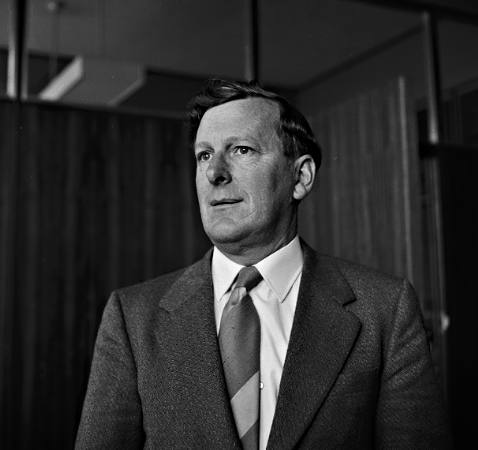
Don Tatnell, City Engineer. Courtesy Leader Collection.
Ten years after it was opened extensions were made to the Tatnell Centre. Partially funded by the Australian Bi-centennial Authority, an additional spa, steam room and sauna were added. Further improvements included a gymnasium in 1993 but a few years later the facility was described as ‘tired’ with ‘under-utilized rundown squash courts’. Utilization of the centre had plateaued and there were no signs of growth. The Council was aware of the need for a leisure centre in the south-eastern section of the municipality but were concerned about the cost of refurbishment. [16] Fortunately, an agreement was reached with SCOPE (previously known as the Spastic Society of Victoria) that facilitated the overhaul and improvements to the Tatnell Centre.
SCOPE was, and continues to be, a non profit organisation providing disability services throughout Victoria to thousands of children and adults with physical and multiple disabilities. They had an ageing day facility centre opposite Mordialloc College where services were provided for members but they were searching for something better. For some time they had been using the Mordialloc Community and Youth Centre on a Sunday for basketball and physical education so they commenced discussions with the Kingston Council exploring the possibility of stronger relationship. SCOPE had $400,000 to invest which they were prepared to contribute to the refurbishment of the Don Tatnell Leisure Centre. The City of Kingston found $150,000 without denuding other capital projects and the Scope Chelsea Parents group contributed approximately $100,000 making the project viable. So a strategic partnership was formed. [17] [18]
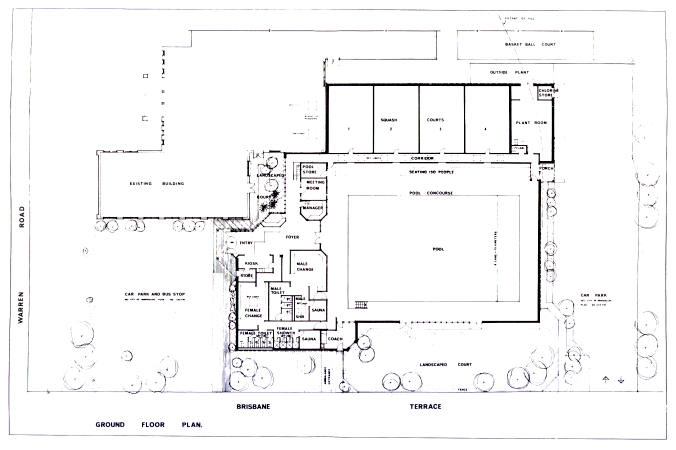
Plan of centre refurbishment. Courtesy Kingston Collection.
The under-utilized squash courts were demolished and replaced with a two-level structure. The upstairs or mezzanine section included an open plan gymnasium while the downstairs arrangements included program rooms shared by both SCOPE and Don Tatnell Leisure Centre together with meeting rooms, kitchenettes and disabled change facilities. The gymnasium overlooking the aquatic facilities is the size of four squash courts. Described as a ‘boutique’ style leisure centre, as it is smaller than most in size, it contains quality equipment with an increased number of specialist staff. The new facility was opened by the Minister for Community Services, Bronwyn Pike 18 September 2002 in the presence of Cr Petchey, Mayor of Kingston, Michael Day Board President of Scope and Joan Holstock of the Scope Chelsea Parents Group. Minister Pike said the Don Tatnell model promised to be a forerunner for other equity models across Victoria. [19]
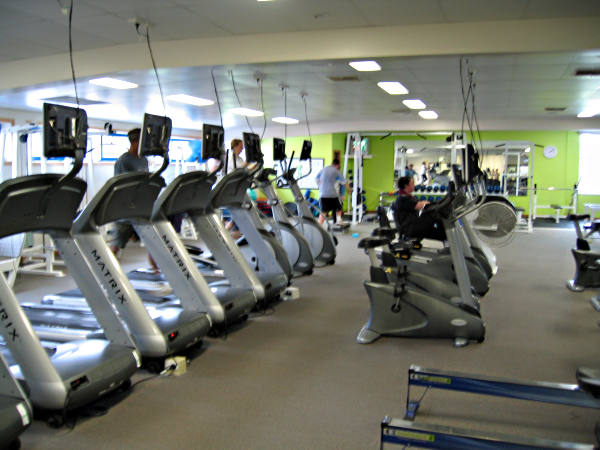
The Open Plan Gymnasium, 2009. Courtesy Kingston Collection.
Footnotes
- The Argus, 1 December 1934.
- See, Whitehead, G. Mordialloc Baths, Kingston Historical Website.
- Chelsea News, 14 September 1935.
- See, Whitehead, G. Mordialloc Community and Youth Centre, Kingston Historical Website.
- Mordialloc City News, 2 April 1959.
- Mordialloc City News, 12 June 1961.
- Mordialloc City News, 3 August 1961.
- Mordialloc City News, 1 November 1962.
- Correspondence – Bill Nixon.
- Members of the committee were John Earp, Bevis Glynne, Brian Howarth, Trevor Ryan, Bill Nixon, John Mason, George Simmons and Jack Touzel.
- Whitehead, G., ‘Interview with Cr Bill Nixon’ January 2009.
- Mordialloc Chelsea News, 18 February 1976.
- Tatnell, D., ‘Swimming Pool Complex Report,’ manuscript, n.d.
- City of Mordialloc Community Youth Centre, Annual Report, 1979.
- Whitehead, G., ‘Interview with Cr Bill Nixon’ January 2009.
- Don Tatnell Leisure Centre/Scope Project.
- Don Tatnell Leisure Centre/Scope Project.
- The total funding of $685,000 came from the Department of Human Services $400,000; Scope $140,000; Scope Parents’ Association $50,000; Kingston City Council $95,000.
- Kingston Your City October 2002.
